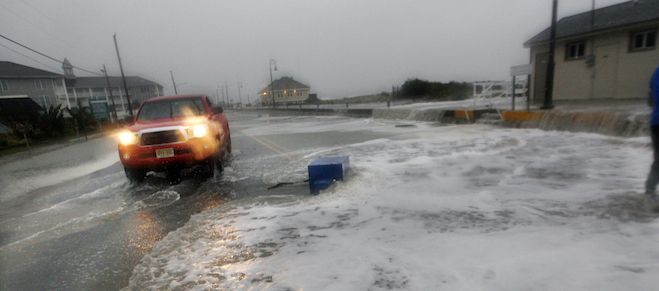Environment Canada, Red Cross issue warnings for Hurricane Sandy
Blackouts possible as high winds down power lines
A truck backs up hastily, as rough surf of the Atlantic Ocean breaks over the beach and across Beach Avenue, Monday, Oct. 29, 2012, in Cape May, N.J., as high tide and Hurricane Sandy begin to arrive. (AP Photo/Mel Evans)
Share

While Americans board up windows and evacuate low-lying areas in anticipation of Hurricane Sandy’s landfall, Environment Canada has also issued warnings to much of the eastern part of the country including parts of Ontario, Quebec and the Maritimes.
In Ontario, “strong and gusty winds will be the main threat with rainfall a lesser concern as Sandy tracks a little farther to the south,” said Environment Canada in a special weather statement, issued early Monday morning. The statement says Ontarians can expect wind gusts of up to 90 km/h and maybe as strong as 100 km/h in the southwestern part of the province, near Sarnia and Niagara.
Moving further east, it will be more of the same in Quebec, particularly in the southern and central part of the province, where strong winds are likely in the St. Lawrence Valley, between Montreal and Quebec City.
In Nova Scotia, Sandy could produce large waves along the Atlantic coast and another front, not associated with Sandy, is expected to bring about 50 mm of rain into the Maritimes, starting on Tuesday.
Winds are likely to cause power outages, as downed trees topple power lines, so the Red Cross issued its own statement Sunday, urging anyone in an affected area to ensure they are able to sustain themselves and their families for 72 hours.
Here’s what’s on the Red Cross checklist to prepare for a potential emergency:
- Water: Store two litres of drinking water and two litres of water for washing per person, per day, keeping a 72-hour supply on hand for your family and any pets
- Food: Store at least a 72-hour supply of non-perishable food for each person. Ensure that there is enough for each member of your family
- Manual can opener
- Crank or battery-operated flashlight, with extra batteries
- Crank or battery-operated radio, with extra batteries
- Extra keys, for house and car
- First aid kit
- Cash in small bills
- Special needs items – medications, baby formula and diapers, and equipment for people with disabilities